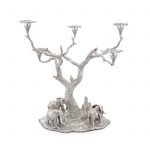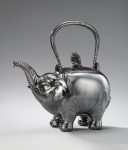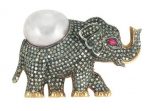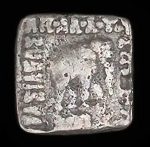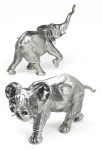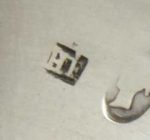Elephants are magnificent animals and have been depicted in silver as far back as the 1st century BC, on both Roman and Greek coins, possibly more. Below are some examples of silver elephants.
Patrick Mavros: a ‘Tree of Lights’ silver candelabrum by Patrick Mavros, also signed ‘Patrick Mavros, Harari May 2002’ Modelled as three elephants beneath a mopane tree, the five lights in the branches with removable drip pans, height 44.5cm, weight 207oz.
Sold for £ 9,375 inc. premium at Bonhams in 2017
Silver Denarius coin.(obverse) Pontifical emblems – culullus, aspergillum, axe and apex. Border of dots. (reverse) Elephant right, trampling dragon; in exergue, inscription. Border of dots.
Reference: © The Trustees of the British Museum
A HAMMERED SILVER KETTLE IN ELEPHANT FORM MEIJI-TAISHO PERIOD, EARLY 20TH CENTURY The silver kettle hammered and constructed as an elephant with tusks, the body applied with a loop handle, the lid set with a silver finial of a recumbent monkey, illegible artist seal and seal jungin ?? on underside. 8 ½ in. (21.6 cm.) long, Japanese wood box
Sold for HKD 375,000 at Christies in 2018
Gold, Silver, Semi-Baroque Cultured Pearl, Diamond and Ruby Elephant Brooch One pearl ap. 17.0 x 16.0 mm., one ruby eye, ap. 17 dwt.
Sold for $1,750 (includes buyer’s premium) at Doyle New York in
Set of two Russian silver elephants – an adult elephant with a baby elephant. Baby elephant is 1 1/8 inches long. The adult is 2 inches high and 3 1/2 inches long.
Sold for $600 at NY Auction Gallery in 2019
The originality and exceptional quality of this emblema dish make it one of the most important items of the silver treasure discovered in 1895 at Boscoreale, in a Roman villa buried by the eruption of Vesuvius in AD 79. The female bust in the center wears an elephant hide and is accompanied by a profusion of symbols whose interpretation remains uncertain: perhaps a portrait of Cleopatra, or her daughter, or an allegorical personification of Africa or Alexandria?
Reference:The Louvre
Elephant Figure Date: 19th century Geography: Republic of Benin, City of Abomey Culture: Fon peoples
Fon silver works such as this silver elephant served as objects of power and prestige owned by a ruler of the Fon kingdom of Dahomey in the present-day Republic of Benin. In the eighteenth and nineteenth centuries, the kingdom of Dahomey prospered as a major center of the international slave trade. The Fon kings were important art patrons who engaged court artists to create items that enhanced their status. During annual festivities called huetantu, these lavish sculptures and textiles were paraded through the capital to celebrate the kingdom’s wealth and military might.
The elephant is associated with both the Dahomey ruler King Guezo (r. 1818–58) and his son Glele (r. 1858–89). The animal is believed to evoke strength, royal legacy, and enduring memory as exemplified in the following proverbs: “There where the elephant passes in the forest, one knows” and “The animal steps on the ground, but the elephants step down with strength.”
Reference: The Metropolitan Museum of Art
Coin, Ancient Greek, Indo-Bactrian, Apollodotus I. c. 1st century BC, silver. Type: obverse elephant to right, Greek inscription, reverse humped bull to right, Karosthi inscription. Made 1st century BC Coin, Ancient Greek, Indo-Bactrian, Apollodotus I. c. 1st century BC, silver. Type: obverse elephant to right, Greek inscription, reverse humped bull to right, Karosthi inscription.
Reference: Museum of Applied Art and Sciences
A PAIR OF GERMAN SILVER ELEPHANTS, B. NERESHEIMER & SÖHNE, HANAU, WITH IMPORT MARKS FOR BERTHOLD MULLER, LONDON, 1908 marked on ears length of longer 17 in. 43.2 cm 103 oz 5 dwt gross 3216 g
Sold for 11,875 USD at Sothebys in 2019
